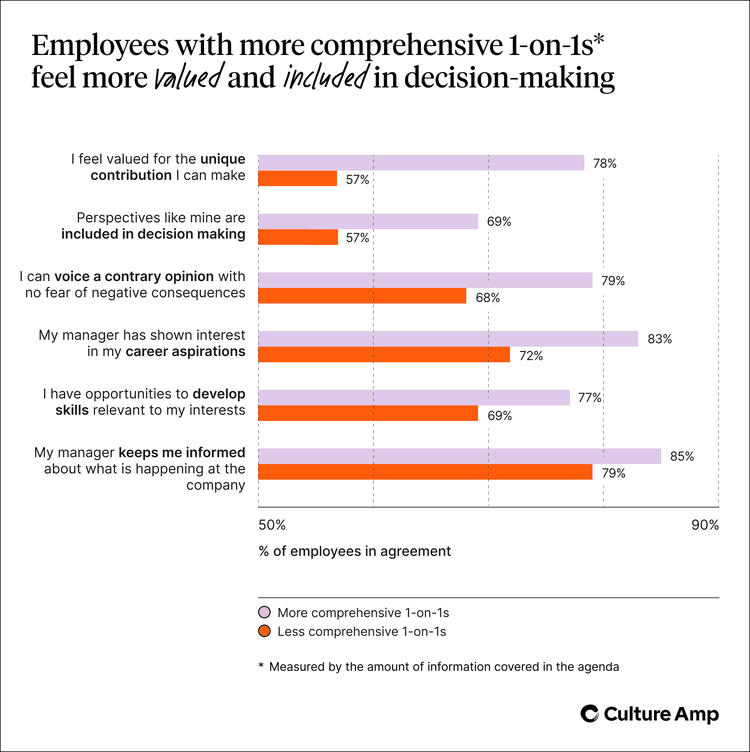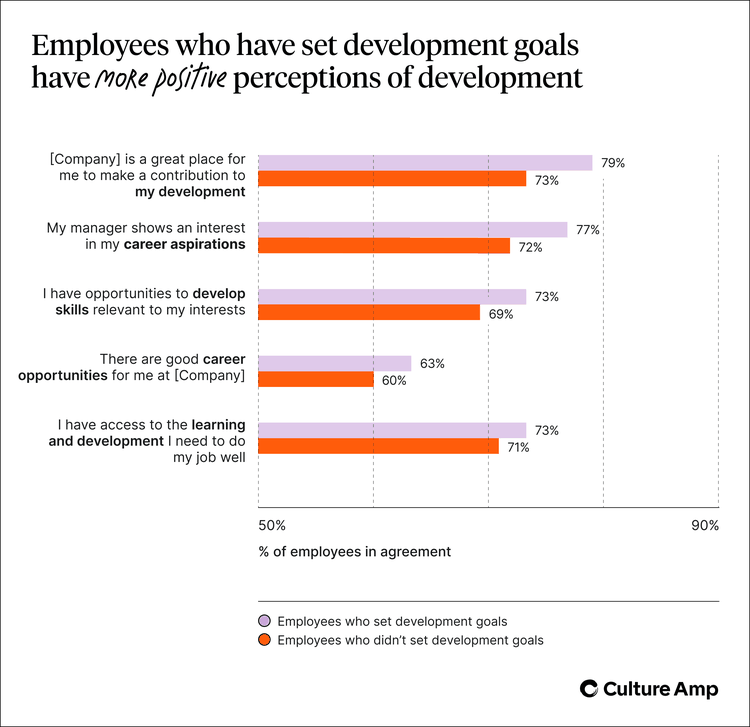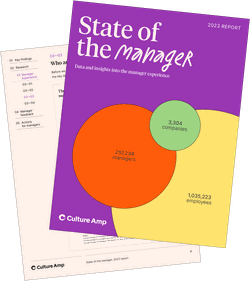
How to be a better manager: 3 focus areas for leaders

Nobody wants to be a bad manager – you want to do your job well. But when you’re juggling all sorts of responsibilities and demands, along with the unique pressures of the past few years, understanding exactly how to be a better manager is challenging.
Fortunately, our research and data provide some helpful insights. In our recent State of the Manager 2023 Report, Culture Amp’s people scientists identified trends and insights from 1,035,223 employees and 257,234 managers at 3,304 companies.
That data revealed the most critical behaviors for leaders to focus on (and why it’s so important for them to do so).
Managers matter: The undeniable impact of good managers
You’ve likely heard the cliché that employees leave managers, not companies. And it’s true that managers greatly influence the overall employee experience.
According to our data, when employees say they have a great manager, they benefit from improved:
- Motivation: Among employees who agree their manager is a great role model, 90% of them say that the company motivates them to go beyond what they would in a similar role elsewhere. Yet only 63% of employees agree with that statement when they disagree or are neutral that their manager is a great role model.
- Retention: Employees with role model managers are nearly half as likely to leave the organization within 12 months compared with employees who don’t have role model managers.
- Company confidence: When employees say their leaders are good managers, they’re more likely to recommend the organization as a great place to work and also report that they have higher confidence in both the company and its leaders.
In short, managers aren’t an aspect of the overall employee experience – they’re the drivers of it.
How to be a better manager: 3 key focus areas for leaders
Because managers have such a powerful impact, many leaders feel pressure to figure out how to be a better manager at work. This can be daunting since managers are already balancing so many needs and expectations.
The good news is that you don’t need to do everything all at once. Our data highlighted three key behaviors that managers can focus on to have maximum impact on their direct reports. These include:
- Hosting meaningful and regular 1-on-1 meetings
- Working with employees to identify and document development goals
- Providing continuous feedback and recognition
Let’s take a look at each of these and the supporting data in a little more detail.
1. Invest time and energy into 1-on-1 meetings
Some managers view 1-on-1 meetings as nothing more than glorified check-ins or status updates. They’re quick meetings that can easily be pushed off if something more pressing comes up.
But in reality, 1-on-1 meetings carry a lot of weight. They’re a chance for leaders and their direct reports to connect, proactively troubleshoot issues, access support and guidance, and strengthen their relationships.
All of that has a major impact on the employee experience, including employees’ desire to stay with the organization. According to our data, direct reports who have 1-on-1s every two weeks have only 9% turnover, while those who never have 1-on-1s have 26% turnover.
Regular 1-on-1s affect not only how employees feel about the organization but also how they feel about their manager.
We found that the more frequently managers hold 1-on-1s, the more likely their direct report agrees that their manager is a great role model for employees. We found:
- 89% of direct reports who have biweekly 1-on-1s agree
- 86% of direct reports who have monthly 1-on-1s agree
- 84% of direct reports with inconsistent 1-on-1s agree
- 82% of direct reports who never have 1-on-1s agree
Moreover, when managers deliver comprehensive 1-on-1s, employees are more likely to agree that their manager shows an interest in their career aspirations and keeps them informed about what is happening at the company.

This data suggests that it’s time to stop overlooking the seemingly humble 1-on-1 meeting and give it the time and attention it deserves. Here are a few tips to help you do so:
- Provide context ahead of time about the purpose and importance of your 1-on-1 meetings, so you and your employees have a shared understanding of their value
- Agree on a shared agenda beforehand (remember to allow the employee to contribute)
- Stay present during the conversation and ask open-ended questions
- Take notes throughout the meeting
- Wrap up your conversation with a summary and agreed-upon action items
2. Clarify development goals
Employees are hungry for clarity, especially related to their performance and growth. Our research shows that employees who have set development goals have more positive perceptions of their development.

Across multiple questions, it’s clear that setting development goals leads to more positive perceptions of employee development in general. Managers should be proactive in helping their direct reports work through their strengths, development opportunities, and what’s next. Use these tips to collaborate with employees to establish goals and hash out action plans:
- Ask employees about their career ambitions, or have them fill out a self-reflection before your conversation
- Match individual goals with company goals to ensure alignment and fuel a sense of purpose
- Document the employee’s goals along with action steps and resources to work toward those objectives
- Have regular development conversations where you check in with your direct report on their progress (your 1-on-1 meetings are a great place to do this)
3. Focus on continuous feedback
Employees can’t develop without both positive and negative feedback from their managers. Don’t sweep important conversations under the rug or reserve them for infrequent performance reviews.
In the report, our people scientists found that high-performing managers are 3x more likely to provide continuous feedback to direct reports. They’re also 2.6 times more likely to have shared their direct report’s performance review with them.
Offering continuous feedback may sound time-consuming, but it doesn’t have to be. Even small steps and changes can make a big difference:
- Use a platform like Culture Amp that makes feedback easy and accessible for both managers and direct reports
- Offer a quick shoutout, compliment, or “thank you” during a team meeting or 1-on-1
- Dedicate a small portion of your 1-on-1 to feedback – both offering feedback to your employee and asking for feedback on your performance as a manager
More responsibility shouldn’t mean less support
As managers tackle these improvement areas, make sure they aren’t alone. Managers don’t just provide support – they need it. Many organizations don’t do enough to support their managers, particularly as managers ascend the hierarchy.
The more direct reports managers have, the less support those managers receive from their own leaders. Our data shows that, when a manager has nine or more direct reports, that manager is 88% less likely to have a 1-on-1 with their leader.
Without adequate guidance and backing, managers struggle to do their jobs at all (let alone successfully). Our report also found that, as managers climb the ladder and acquire more direct reports and responsibilities, they’re less likely to perform crucial manager behaviors like:
- Setting goals with direct reports
- Creating development plans
- Sharing performance reviews
- Providing public recognition and praise
This is not a chance for organizations to point the finger at managers and write them off as unable to handle the pressures of the job. Instead, it’s an opportunity for organizations to pour into their managers and give them adequate support and resources to succeed in their roles.
Do that, and everybody – your managers, your employees, and your entire organization – wins.





